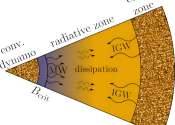Clouds blanket the night side of the hot exoplanet WASP-43b
Using the James Webb Space Telescope (JWST), a team of astronomers, including scientists from MPIA, constructed a global temperature map of the hot, gas giant exoplanet WASP-43b. The nearby parent star perpetually illuminates ...









